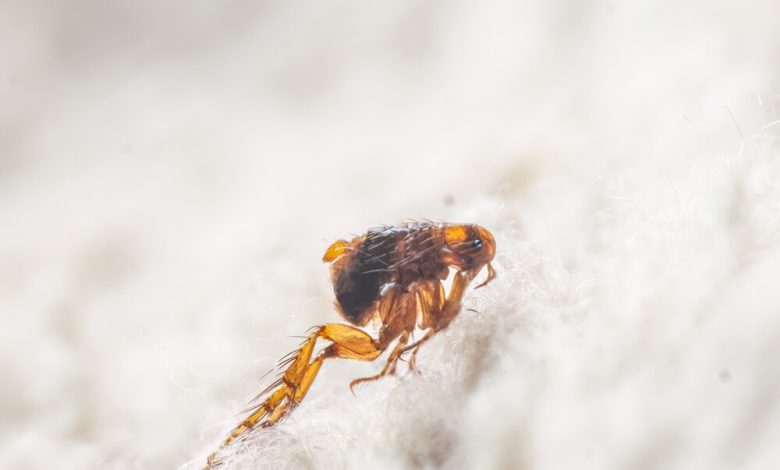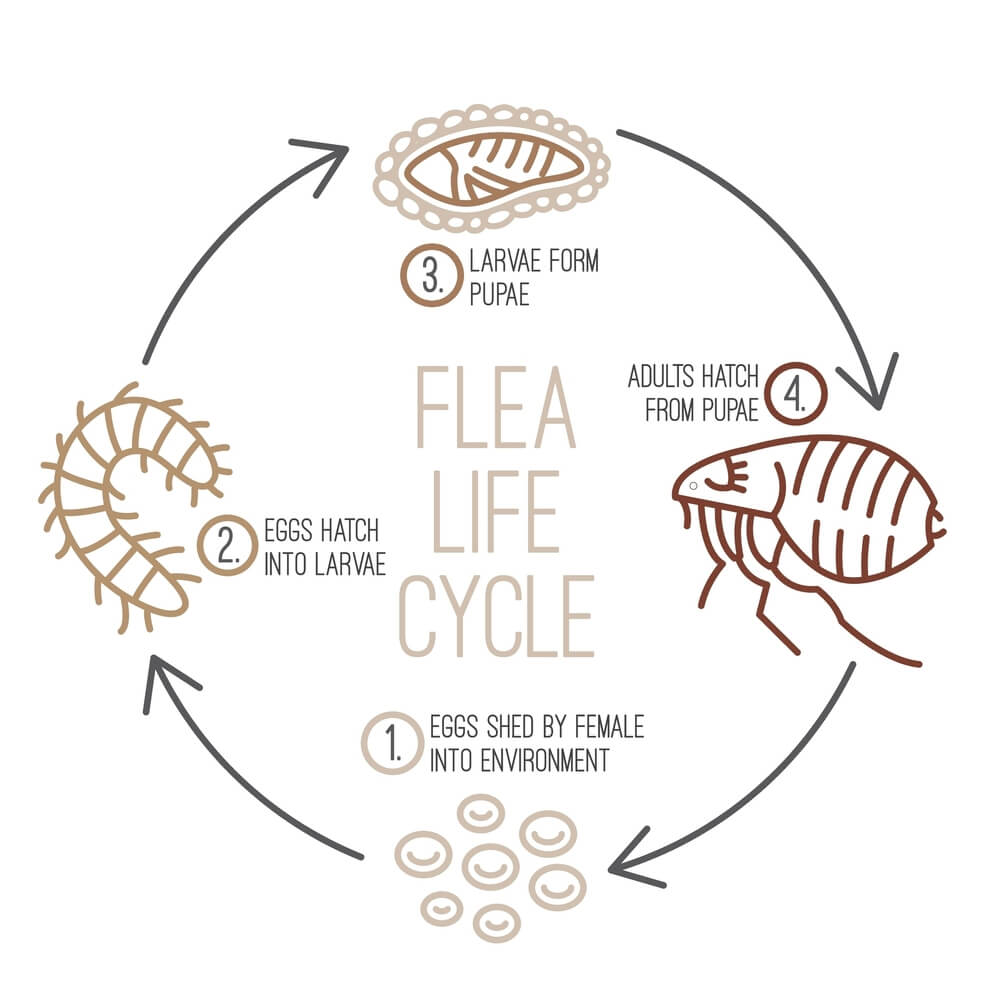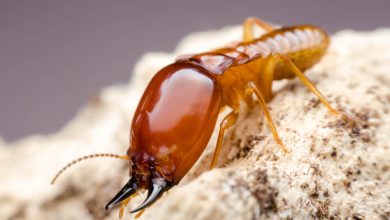What Do Fleas Look Like? A Guide to Identifying Fleas

Fleas are more than nuisances; they cause discomfort and health issues for pets and humans. Identifying them quickly is crucial for effective control. This guide covers their physical characteristics, life cycle, and different types, helping you recognize fleas early. Early detection allows timely action to mitigate their impact and explore effective treatments to keep your environment flea-free.
The Physical Characteristics of Fleas
Fleas are small, wingless insects that are notorious for their role as parasites on pets and other animals. Understanding the physical characteristics of fleas is essential for identifying and managing infestations.
Flea size varies but typically ranges from 1/16 to 1/8 of an inch (1.5 to 3.3 millimeters) in length. Despite their tiny stature, fleas are easily recognizable due to their distinct shape. They possess a laterally compressed body, which allows them to navigate through the fur of their hosts with ease. This flattened shape also aids in their ability to jump great distances relative to their size.
In terms of color, adult fleas are usually reddish-brown or dark brown, which can make them difficult to spot against the skin or fur of pets. When examining a flea under a microscope, you will notice its hard exoskeleton and powerful hind legs designed for jumping.
Identifying fleas on pets involves looking for these small, dark insects moving quickly through the fur or noticing signs such as excessive scratching or red bumps on your pet’s skin. Flea dirt (flea feces) is another indicator; it appears as tiny black specks on your pet’s coat or bedding.
Common Types of Fleas and Their Distinct Features
Fleas are a common concern for pet owners and can also affect humans. Understanding the different kinds of fleas and their distinct features can help in effectively managing and preventing infestations.
One of the most prevalent types is the cat flea (Ctenocephalides felis), which, despite its name, infests both cats and dogs. Cat fleas are small, dark brown, and have long legs that enable them to jump considerable distances. They are known for their resilience and ability to reproduce quickly.
Dog fleas (Ctenocephalides canis) are another common species but are less widespread than cat fleas. They appear similar in size and color to cat fleas but have a more rounded head. Dog fleas primarily infest dogs but can also be found on other animals including cats.
When it comes to types of fleas on humans, Pulex irritans or the human flea is noteworthy. These fleas prefer human hosts but will also feed on pigs or other mammals if necessary. Human fleas are slightly larger than cat or dog fleas and lack combs (genal or pronotal) that many other flea species possess.
Distinguishing between flea species often requires close examination, sometimes under a microscope, as many share similar characteristics such as size and color. However, understanding these subtle differences is crucial for targeted treatment approaches.
By recognizing the specific type of flea causing an infestation, you can better tailor your pest control methods to eliminate these pests from your environment effectively.
The Life Cycle of a Flea

The life cycle of a flea is a fascinating and complex process that encompasses four distinct stages: egg, larva, pupa, and adult. Understanding these flea life stages is crucial for effective pest control and prevention.
Flea eggs are the starting point of this cycle. They are tiny, oval-shaped, and typically white or translucent in appearance. Measuring about 0.5 millimeters in length, flea eggs are often laid on the host animal but can easily fall off into the surrounding environment such as carpets or bedding.
Following the egg stage is the larval stage. Flea larvae emerge from their eggs within a few days to two weeks, depending on environmental conditions like temperature and humidity. These larvae are worm-like in appearance and measure about 2-5 millimeters long. They feed on organic debris found in their environment, including adult flea feces.
After feeding sufficiently during the larval stage, fleas enter the pupal stage by spinning a silken cocoon around themselves. This cocoon provides protection as they undergo metamorphosis into adult fleas. The pupae can remain dormant for several days to months until they sense favorable conditions such as vibrations or increased levels of carbon dioxide indicating a nearby host.
Finally, adult fleas emerge from their cocoons ready to find a host for blood meals necessary for reproduction. Adult fleas are small (about 1-3 millimeters), dark brown insects with flattened bodies that allow them to move easily through fur or feathers. They possess strong hind legs adapted for jumping great distances relative to their size up to 200 times their body length.
How to Spot Flea Infestations in Your Home and Pets
One of the primary signs of fleas in your home is the presence of flea dirt. Flea dirt looks like tiny black pepper flakes and is essentially flea feces. You can find it on pet bedding, carpets, or furniture where pets frequently rest. To check for flea dirt on your pets, use a fine-toothed comb to part their fur, especially around the neck and tail areas. If you find black specks that turn red when moistened with water, it’s likely flea dirt.
Detecting fleas on dogs and cats involves closely inspecting their skin for small, fast-moving insects. Fleas are typically brownish-red and about 1-2 mm in size. Pets may exhibit symptoms such as excessive scratching, biting at their fur, or hair loss due to constant irritation.
Symptoms of flea bites on pets include redness or raised bumps at bite sites, which can lead to secondary infections if scratched excessively. Humans might experience similar symptoms from flea bites, such as small red spots that itch intensely.
Differentiating Between Flea Bites and Other Insect Bites or Skin Conditions
Differentiating between flea bites and other insect bites or skin conditions can be crucial for effective treatment and prevention. Flea bites typically appear as small, red bumps that often occur in clusters on the lower legs and ankles. These bites are intensely itchy and may develop into a rash if scratched excessively.
In contrast, mosquito bites are usually isolated, raised welts with a central puncture point. They tend to be larger than flea bites and can appear anywhere on the body. Mosquito bites also cause itching but generally subside within a few days.
Bed bug bites present another distinct pattern. These bites often manifest in linear or clustered groups of three to five welts, commonly referred to as “breakfast, lunch, and dinner” lines. Bed bug bite marks are usually found on exposed areas like the face, neck, arms, and hands.
Allergic reactions to insect bites can complicate identification further. Such reactions might cause widespread redness, swelling beyond the bite area, or even hives. In severe cases, they could lead to an anaphylaxis, a life-threatening condition requiring immediate medical attention.
Understanding these differences is essential for accurate diagnosis and appropriate treatment. Proper identification helps target specific pests more effectively while ensuring timely relief from symptoms associated with their bites.
Treatment Options After Identifying a Flea Problem
Once a flea problem has been identified, it’s crucial to act swiftly and efficiently to address the issue. Flea treatment for homes and pets involves a multi-faceted approach to ensure thorough eradication and prevention of future infestations.
Firstly, treating your pets is paramount. There are various flea control products available, such as topical treatments, oral medications, and flea collars. These products are designed to kill fleas on contact or disrupt their life cycle. It’s essential to consult with your veterinarian to choose the most suitable option for your pet’s health and lifestyle.
Simultaneously, addressing the home environment is critical. Begin by thoroughly vacuuming carpets, rugs, furniture, and pet bedding to remove fleas at all life stages. Washing pet bedding in hot water can also help eliminate any remaining fleas or eggs. In more severe cases, you might consider using flea sprays or foggers specifically designed for indoor use.
Treating your yard for fleas is another vital step in controlling an infestation. Fleas often thrive in shaded areas where pets frequent. Applying outdoor flea control products can significantly reduce their population in these areas. Additionally, regular lawn maintenance, such as mowing the grass and removing debris, can make your yard less hospitable to fleas.
Preventive measures are equally important once you’ve managed an infestation. Implementing consistent flea prevention methods can help keep future problems at bay. Regularly treating pets with preventive products recommended by veterinarians ensures they remain protected year-round.
Effective flea treatment requires a comprehensive strategy that includes treating both pets and their environment while maintaining ongoing preventive measures to safeguard against future infestations.
Effective Strategies for Preventing Future Infestations Once You Know What Fleas Look Like
Understanding what fleas look like is the first crucial step in safeguarding your home and pets from these persistent pests. Once you can identify fleas, implementing effective strategies to prevent future infestations becomes much easier. Here are some key measures to consider:
- Regular Pet Inspections and Grooming: Regularly check your pets for signs of fleas, especially after they have been outdoors. Grooming them frequently with a fine-toothed flea comb can help catch any fleas early before an infestation takes hold.
- Maintain Clean Living Spaces: Vacuum carpets, rugs, and upholstery regularly to remove flea eggs and larvae that may have settled in these areas. Washing pet bedding in hot water weekly can also significantly reduce the chances of an infestation.
- Use Preventative Treatments: Consult with your veterinarian about appropriate flea prevention treatments for your pets, such as topical solutions, oral medications, or flea collars. These treatments are designed to repel or kill fleas before they can establish themselves.
- Yard Maintenance: Keep your yard well-maintained by mowing the grass regularly and removing leaf litter where fleas might thrive. Consider using environmentally friendly outdoor flea control products if you live in an area prone to infestations.
- Seal Entry Points: Ensure that doors, windows, and other potential entry points are properly sealed to prevent fleas from entering your home from outside environments.
By integrating these strategies into your routine once you know what fleas look like, you can effectively minimize the risk of future infestations and maintain a healthier environment for both you and your pets.




